| INKJET PAPERS |
 |
| When you make the choice to print an image, whether it is a fine art reproduction or a photograph, paper selection is the most important part of your decision process. The way the paper was formulated affects how the inks will be absorbed, and the amount of sideways expansion (bleed) each dot of ink will The end result must suit the style of the print as well as your own personal vision for the image. Different inkjet printer papers can lend a sharpness to your urban skyline, or give a foggy landscape an ethereal, painterly quality. There are a great number of inkjet papers available today.
At KeenART Media, we offer a wide range of fine art and photographic papers for inkjet Giclée prints. The following article discusses the properties of papers used in printing, and lists many of the most popular types.
|
SUMMARY
| PAPER TYPE |
IDEAL USE |
PHYSICAL PROPERTIES |
VISUAL PROPERTIES |
| Resin-Coated |
General photographic prints |
Smooth texture, thin and lightweight |
Glossy finish (satin, luster, semi-gloss), very white/bright |
| Metallic |
Photographic prints of metal objects, black and white images |
Smooth texture, mid-range thickness and weight |
Glossy finish with metallic sheen, mid-range brightness |
| Baryta |
Black and white photographic prints |
Smooth texture, mid-range thickness, heavyweight |
Glossy finish, very high brightness |
| Cotton |
High quality fine art or photographic prints for sale or exhibition |
Smooth or rough texture, range of thicknesses and weights |
Matte finish, natural brightness |
| Canvas |
Fine art reproductions and some photographs |
Rough, traditional texture, thick and heavyweight |
Semi-matte finish, very high brightness |
|
| INKJET PAPER QUALITIES
|
 |
|
There are countless terms and descriptors that relate to paper selection. While many of these terms will simply confuse matters, and may not even be provided by the manufacturer, others are essential to understand if your goal is to product the best prints possible for your selected images.
Often, the manufacturer's specifications about a paper will look something like this:
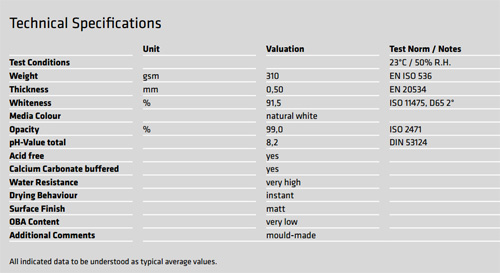
These specs are for Hahnemuehle brand German Etching paper.
While some of the terms shown here are pretty self explanatory (Drying behavior: instant, for example) or unnecessary for basic paper selection, others are essential to understand when choosing the ideal paper for a specific image.
|
| PHYSICAL PROPERTIES
|
 |
WEIGHT
Paper weight is determined by a uniform measurement system. The weight in pounds that you will see on many reams of paper is based on 500 sheets of 17x22" paper (that's four letter-sized, 8.5x11" pieces). If a ream of 500 8.5x11" sheets of paper is marked as 20 lbs (regular bond paper), the stack itself weighs one quarter of that - 5 lbs - and each sheet weighs 0.01 lbs.
Just to confuse things, though, fine art papers are often weighed by grams per square meter (39.37 square inches), instead of pounds. In the example shown above, you can see the weight is 310 gsm. This weight is approximately equivalent to an 87 lb paper.
In the end, all you need to note is the difference in weight between the papers - the specific weight doesn't really matter. If you have lifted and felt a 310 gsm paper, then you will know that a 190 gsm paper will be somewhat lighter. It will most likely be thinner as well, though it is important to note that weight does not directly correlate with thickness.
CALIPER
Caliper is really just a fancy word for thickness. Fine art paper thickness is measured either in "mil": 1/1000th of an inch, or in millimeters: 1 inch = 25.4 mm. The example above shows a thickness of 0.5mm, which is equivalent to 20 mil.
Much like the paper weight, being able to envision the exact thickness of a paper isn't important. Rather you can recognize that a 15 mil (0.38 mm) Hot Press paper will be slightly thinner than the German Etching paper above.
Generally, regular printer papers have thicknesses of 4 to 10.5 mil, and photo papers 7 to 10 mil.
TEXTURE
Texture refers to the feel of the paper, which can range from a silky smooth velvet to a bumpy, pockmarked surface. While photographic papers are all of a smooth finish, many fine art papers have some sort of uneven texture. This has to do with how fine the wood or cotton pulp was when it was formed into the paper, and the texture of the press that made the paper into the flat sheets used for printing.
Etching papers (like the spec example above) and watercolor papers usually have a more textured surface than Baryta or basic Cotton Rag papers. Hot Press papers will have a smooth finish, while Cold Press denotes texture.
The texture of the paper will affect how your final image appears. Textured papers can hide some slight pixelation or noise, and tend to give images a painterly quality. Smooth papers showcase your image very much as it appeared on the screen, and allow for sharp contrasts and lines.
|
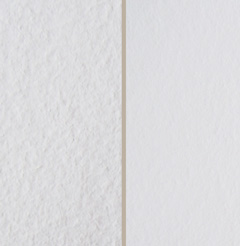
Left: Rough texture; Right: Smooth texture
|
| VISUAL PROPERTIES
|
 |
|
This section contains some basic color theory. To read more about this, see our article all about color.
WHITENESS AND BRIGHTNESS
The light reflectance of the paper. Whiteness considers all wavelengths (colors), while Brightness is specific to the wavelength that creates blue light. Both properties are measured on a scale of zero to 100, where a 90 bright paper reflects more light than an 80 bright paper.
Some papers are labelled with brightnesses of more than 100. This implies that chemical OBAs (optical brightening agents) have been added to artificially enhance the white paper.
SHADE
Shade refers to the color of the paper or specifically, as defined by Xerox, the "subtle differences in color within the visible spectrum." Much like paint chips at the home decor store will have many white options - eggshell, off white, pure white, snow white, etc - papers can have different shades as well.
White is generally broken down into three broad categories, to which countless different names may be applied. These categories are True White, Cream White, and Blue White. This comes down to wavelengths again. Cream whites reflect (show off) warmer colors like yellow, blue whites reflect cooler colors like blue, and true whites reflects the entire color spectrum equally.
Like all colored objects, the shade of a certain paper will look different depending on the type and amount of light to which it is exposed at any given time. Our example paper is described as natural white and has a brightness of 92 (not shown in specs). As you can see in the specs, the OBA content is very low in this paper.
OPACITY
Opacity is the opposite of transparency; in other words, the higher the opacity, the less see-through the paper is. This is determined by how much light can pass through the paper, or how visible the printed image is from the back when the paper is held up to the light.
Opacity is measured, like brightness, on a scale of zero to 100. Inkjet photo papers are usually 94 to 97 opacity. The German Etching paper in our example is 99 opacity, which is common for fine art papers, which tend to range from 97 to 99.
FINISH
This term refers to the shininess of the paper, and is one of the qualities that will most strongly affect the appearance of your print. There are two basic categories of finishes.
- Glossy Finish: This finish gives the paper a high shine, reflective appearance and will have a smooth, glossy feel, just like the family photographs you probably have around your home, in picture frames, albums, or on the refrigerator. As such, this paper used primarily for printing photos, and rarely used for painting or pencil art reproductions.
There are many sub categories of gloss papers, including high gloss, soft gloss, semi-gloss, and satin (less shiny). When selecting a paper for your image, it is important to remember that glossy papers are the least forgiving of imperfections in the picture, such as pixelation, dust spots from the lens, or noise.
- Matte Finish: This finish has no reflective quality, and may be smooth or textured, though matte photo papers are always smooth. Matte papers create a soft, rich color and are usually intended to display images behind glass. Semi-matte papers are available, and the satin paper mentioned above will fall somewhere between a matte and glossy paper.
|
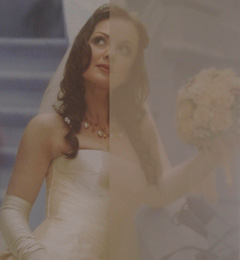
Left: 90% opacity; Right: 96% opacity
Viewed from back of paper
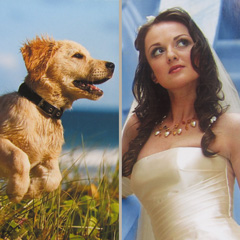
Left: Matte finish; Right: Glossy finish
|
| INKJET PAPER TYPES
|
 |
RESIN COATED (RC) PAPER
Named for the traditional photo papers that were used in dark rooms (silver halide papers), these papers are made from refined wood pulp encased between layers of polyethylene plastic, with an ink receptive coating. They have a glossy finish that ranged from high gloss to a subdued pearl or satin.
Though they are more water and scratch resistant than matte papers, they are thinner and can therefore appear "cheaper" when examined. Some professional photographers recommend avoiding these papers for prints you may wish to sell, as museums, galleries, and collectors will generally not accept them.
For regular use, though, they are perfectly suitable. They can deliver deep blacks and white whites, with excellent contrast and sharpness (assuming, of course, that the digital image is high resolution to begin with).
METALLIC PAPER
Another paper within the Glossy category is metallic paper. Inspired by silver halide papers of old, your prints will exhibit a slightly warm tone and a unique sheen. Images printed on metallic paper have strong luminance and reflective qualities, and impart an almost three dimensional appearance.
Blacks will appear very rich, and with high contrast, on metallic paper, and the color gamut (the range of colors the paper can support) is very wide. This paper is ideal for images of objects made of metal: vehicles, farm silos, etc.
COTTON FIBER/ALPHA CELLULOSE PAPER
The most expensive fine art papers on the market are made from 100% cotton fiber (sometimes referred to as cotton "rag"). If they are identified as Alpha Cellulose, they are free of any chemicals or naturally occuring wood substances that could cause degradation or yellowing, and therefore conservation quality. This means they are used by museums and galleries, and have a lifespan of at least 100 years when properly protected and displayed.
- Etching papers (textured)
- Hot Press papers (smooth)
- Cold Press papers (textured)
FIBER-BASED BARYTA PAPER
A smooth paper generally constructed from cotton or other alpha-cellulose (acid and lignin-free) fiber, baryta papers provide a very rich black color and fine grays, with excellent color gamut, contrast and sharpness.
CANVAS
Canvas, usually a polyester-cotton blend, can be used to print photographs and fine art reproductions. With the texture of traditional artist's canvas, this substrate offers the advantage of displaying the image without a frame - canvas prints are very durable, treated with a protective varnish to ward off dust, scratches, and fading.
SPECIALTY PAPERS
Though less common than the papers above, substrates made from alternate sources are growing in popularity. These natural materials include:
- Bamboo
- Sugarcane
- Mulberry
- Hemp
|
| Whatever qualities you are seeking for your final photographic or fine art print, there is a paper that can achieve it for you. Though this article includes suggestions as to the best uses for each paper, there are no set rules. All print shops can supply you with samples of the papers you are considering, so you can compare weights, textures, and color densities. Try out different papers on the same image to figure out which one will give you the desired results.
To read more about the different substrates beyond paper that can printed with inkjet technology, read our Types of Print Media article. If you have any questions about our products or services, please don't hesitate to contact us. Our knowledgeable staff can walk you through the process and provide suggestions and advice.
|
| Sample Packs - Fine art papers: |
 |
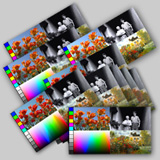 |
The KeenARTS Sample Pack allows photographers and artists to see and compare the KeenARTS's sample image printed on different papers and media prior to ordering online prints.
Size: 8-3/4" x 5" sample pack, 14 sheets
Order the sample pack online: Sample Packs - Fine art papers
|
|
© 2002-2024 - KeenART Media Ltd.
|
|
| |
|

